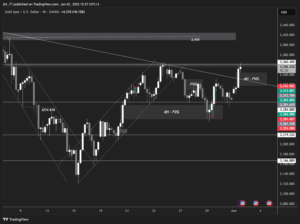The Atlanta Fed chief favors raising rates by 25 basis points this month.
The chair of the Atlanta Federal Reserve said the impact of higher interest rates on the economy could start to feel real in the spring, calling for continued rate hikes at a pace of 25 basis points.
“I still think that raising interest rates at a steady and slow pace is the appropriate course of action,” said “Raphael Bostick” in statements to reporters: “The cumulative effect of increasing interest rates should appear in the spring.”
Bostick believes the Fed may be close to a stopping point, having raised borrowing costs from near zero a year ago to a restrictive range of 4.5%-4.75% in February. Most financial market expectations indicate that the Federal Reserve may raise interest rates by 25 basis points on the 22nd of March after a similar increase on the 1st of February.
The dollar heads for its first weekly loss since January.
The dollar retreated from the highest level in two and a half months against the yen today, Friday, and headed towards recording its first weekly loss since January against other major currencies as dealers try to determine the course of the Federal Reserve’s monetary policy.
The yen, particularly sensitive to long-term interest rate differentials between the US and Japan, threatened to extend its weekly losing streak to seven weeks, even as it gained momentum on Friday as US 10-year Treasury yields fell from their highest level in nearly four months.
The comments of Rafael Bostick, Chairman of the Federal Reserve Board in Atlanta, led to the dissipation of some of the dollar’s strength and the rise in Treasury yields, as he said last night that “raising interest slowly and steadily will be the appropriate course of action,” despite the new employment data that was added to Series of strong statements recently.
The dollar index, which measures the performance of the US currency against the yen, the euro, and four other major currencies, fell by 0.11% to 104.85, from the high level of 105.36 recorded a few days ago, which is the highest level since January 6th. It has decreased by since last Friday by 0.36%.
The Bank of Japan is expected to remove the extraordinary stimulus measures after Governor Haruhiko Kuroda retires next month. Tokyo inflation data for February exceeded the BoJ’s target for the ninth month, but the underlying gauge slowed from a 42-year high. The dollar fell 0.15% to 136.575 yen after rising to 137.10 overnight, the highest level since December 20. The euro rose 0.08% to $1.0606. Since last Friday, it has advanced by 0.59%.
Gold prices are rising, heading towards recording the most significant weekly gain since January.
Gold prices rose on Friday, on track for their biggest weekly gain since mid-January, as traders assessed how far the Federal Reserve would continue to raise interest rates.
Atlanta Fed President Rafael Bostick said it was consistent with the 5% to 5.25% interest target proposed by the FOMC last year but cautioned that rates should remain high through 2024.
And futures contracts for the yellow metal for April delivery rose 0.47% at $ 1849.10 an ounce at exactly 07:15 GMT. The spot price for delivery rose 0.37%, or $6.71, to $1842.58 an ounce, bringing its recorded gains this week to 1.6%.
Silver futures contracts for May delivery increased by 1.1% to $21.13 an ounce, the spot price of platinum rose 0.44% at $968.95, and palladium rose 0.16% to $1453.91.
US stocks closed higher after a Fed official’s comments on interest rates.
US stocks rose on Thursday as Treasury yields retreated from earlier highs, following comments from Atlanta Federal Reserve Chair Rafael Bostick about the path of raising interest rates by the US central bank.
Based on preliminary data, the Standard & Poor’s 500 index closed up 29.90 points, or 0.76%, to 3981.29 points, the Nasdaq Composite Index rose 83.43 points, or 0.73%, to 11462.92 points, and the Dow Jones Industrial Average rose 341.73 points, or 1.05%, to 33003.57 points.
Salesforce stock jumped 12%, notching its highest daily gain since August 2020. The cloud-based software company forecasted higher-than-analyst estimates for first-quarter revenue and doubled its share buybacks to $20 billion.
In the Thursday session, Tesla shares fell by 6%, equivalent to about $12 per share, recording its lowest closing in a month, losing $200 levels, and closing at $190.9.
This pressure comes after CEO Elon Musk and the team’s 4-hour presentation could have convinced investors with more details about the company’s plan to produce an affordable electric car.
Bitcoin fell to its lowest level in two weeks.
Cryptocurrencies fell on Friday, with bitcoin hitting a two-week low, as the industry absorbed the fallout from the problem plaguing US bank Silvergate Capital.
Silvergate offers a widely used payments network that facilitates real-time funds transfer between cryptocurrency firms. Still, many digital asset exchanges and stablecoin issuers no longer accept payments through a bank.
The Silvergate issue is the latest example of infection caused by the collapse of the cryptocurrency exchange FTX in November.
Bitcoin fell 4.68% to $22,366.64 at 06:08 GMT, according to Coinbase data, extending its weekly losses to 4.78%. Ethereum fell by 4.60% to $1,568.5, and ripple fell by 2.91%, at 36.78 cents.
Japanese stocks rose to their highest level in 3 months.
Japanese stocks rose at the end of the week’s sessions after the services sector grew faster in eight months.
A particular survey released Friday by au Jibun Bank showed Japan’s services PMI rose to 54 points in February, up from 52.3 points recorded in January.
Government data announced a slowdown in the core consumer price index as government energy subsidies took effect, rising by 3.3% in February annually, in line with expectations.
The yield of Japanese bonds for ten years rose above the maximum limit set by the central bank amid a wave of selling global bonds.
Before erasing those gains, the bond yield rose 0.5 basis points to 0.505%, ahead of Governor Haruhiko Kuroda’s latest monetary policy meeting on March 10th.
The Nikkei index rose at the end of the session by 1.56% at 27,927 points to reach its highest level since December 15, recording a weekly gain of about 1.65%. The broader Topix index rose 1.25% to 2,019 points. The US currency fell against its Japanese counterpart, by 0.21%, at 136.48 yen, at exactly 07:06 GMT.
Oil is heading to record weekly gains amid hopes for strong growth in Chinese demand.
Oil prices fell in early trading today, Friday, but are set to record a weekly gain of about 2%, as the recovery of factory activity in China offset the impact of escalating concerns about the increase in US crude stocks and the possibility of raising interest rates in Europe.
Brent crude futures fell 32 cents, or 0.38%, to $84.43 a barrel. US crude futures fell 31 cents, or 0.40%, to $77.85 a barrel, at 04:02 GMT.
Despite its decline today, Friday, Brent crude rose by about 1.6% since the beginning of the week and is on its way to recording a second weekly gain. In comparison, US crude jumped nearly 2% after a slight loss in the previous week, thanks to hopes for strong growth in fuel demand in China—the largest importer of oil in the world.
China’s manufacturing activity grew last month at the fastest pace in over a decade, boosting expectations of a recovery in the world’s second-largest economy after onerous anti-COVID-19 restrictions were lifted.
China’s seaborne imports of Russian oil are expected to hit a record high this month as refineries benefit from lower prices.
Comments from Atlanta Federal Reserve Chairman Rafael Bostick, in which he said the US central bank should continue to raise interest rates by a “steady” quarter of a percentage point, soothed fears in the United States and helped support oil prices on Thursday even after US data. Strong unemployment.
However, the market remains wary of a faster-than-expected rise in consumer prices in France, Spain, and Germany, which reinforces expectations of further rate hikes by the European Central Bank.
Inflation in the eurozone rose to a higher-than-expected annual rate of 8.5% in February, according to a preliminary estimate from the European Union’s statistics agency. Tenth straight weekly increases in US crude oil inventories also weighed on the market this week.
Disclaimer: This article is not investment advice or an investment recommendation and should not be considered as such. The information above is not an invitation to trade and it does not guarantee or predict future performance. The investor is solely responsible for the risk of their decisions. The analysis and commentary presented do not include any consideration of your personal investment objectives, financial circumstances, or needs.





